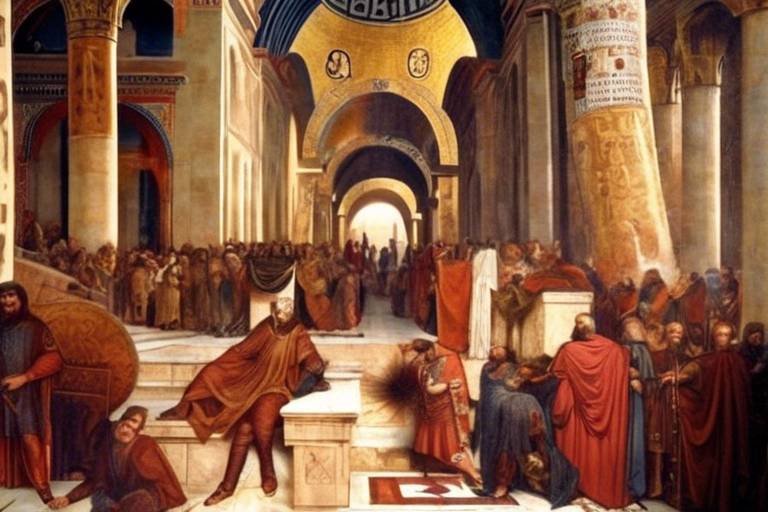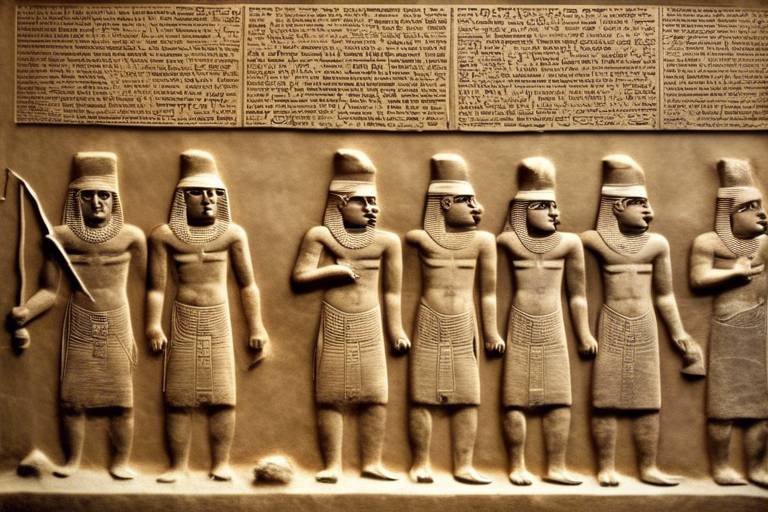The Rise and Fall of the Mauryan Empire - Insights
Exploring the historical trajectory of the Mauryan Empire, from its ascension to power under Chandragupta Maurya to its eventual decline after the reign of Ashoka, sheds light on key events and factors that shaped its destiny. The rise of the Mauryan Empire marked a significant period in ancient Indian history, characterized by military conquests, economic prosperity, and cultural achievements. However, the empire's fall was equally dramatic, plagued by internal conflicts, external invasions, and the challenges of governance over a vast territory.

Founding of the Mauryan Empire
Establishing itself as one of the most powerful empires in ancient India, the Mauryan Empire was founded by the legendary Chandragupta Maurya. Rising to prominence through a series of strategic conquests and alliances, Chandragupta, with the guidance of his mentor Chanakya, laid the foundation for a vast empire that would shape the course of Indian history.
Chandragupta's military campaigns were marked by tactical brilliance and a keen understanding of the political landscape of his time. By forging alliances with local rulers and defeating his adversaries on the battlefield, he expanded his territory and solidified his control over a vast expanse of land.
The consolidation of power in ancient India was not an easy feat, yet Chandragupta's astute leadership and vision enabled him to establish a strong central authority that brought stability and order to the region. Through a combination of military might and diplomatic finesse, the Mauryan Empire emerged as a formidable force in the Indian subcontinent.
Central to the success of the Mauryan Empire was the strategic location of its capital, Pataliputra. Situated at the confluence of major trade routes, the city served as a hub for economic activity and administrative affairs. The development of infrastructure, including the construction of roads and irrigation systems, facilitated trade and communication, further enhancing the empire's prosperity.
Moreover, Chandragupta's efficient administration and governance structure laid the groundwork for the empire's continued expansion and influence. By appointing capable governors to oversee different regions and maintain law and order, he ensured the smooth functioning of the empire's vast territories.
In essence, the founding of the Mauryan Empire under Chandragupta Maurya marked the beginning of a golden era in Indian history, characterized by military prowess, administrative excellence, and economic prosperity. The legacy of his reign would endure for centuries, leaving an indelible mark on the cultural and political landscape of the subcontinent.

Ashoka the Great
During his reign, Ashoka, also known as Ashoka the Great, played a pivotal role in shaping the Mauryan Empire's history. His conversion to Buddhism marked a significant turning point, as he embraced the teachings of the Buddha and adopted a policy of non-violence and compassion. This transformation had a profound impact on the empire's governance and society, leading to a period of relative peace and stability.
Ashoka's promotion of Dhamma, a concept encompassing moral and ethical principles, aimed to foster harmony among his subjects and promote social welfare. His edicts, inscribed on pillars and rocks throughout the empire, conveyed his message of tolerance, respect for all religious beliefs, and the importance of righteous conduct. This emphasis on moral values and the well-being of his people distinguished Ashoka's rule and left a lasting legacy on the Mauryan Empire.
Furthermore, Ashoka's policies extended beyond ethical considerations to encompass administrative reforms and infrastructure development. He implemented measures to improve the lives of his subjects, including the establishment of hospitals, animal shelters, and the promotion of trade and agriculture. Ashoka's benevolent governance and focus on public welfare contributed to the empire's prosperity and social cohesion.
Despite his commitment to non-violence, Ashoka did not neglect the military aspects of governance. He maintained a well-organized army to defend the empire's borders and ensure internal security. Ashoka's strategic military alliances and diplomatic efforts helped safeguard the Mauryan Empire from external threats and internal unrest, reinforcing his reputation as a capable ruler.
Overall, Ashoka the Great's reign symbolizes a period of enlightenment and humanitarian values in the history of the Mauryan Empire. His legacy as a compassionate and visionary leader continues to inspire generations, reflecting the enduring impact of his reign on ancient Indian civilization.

Economic Prosperity and Infrastructure
The Mauryan Empire experienced a period of remarkable economic prosperity and infrastructure development under the reign of Chandragupta Maurya and his successors. Chandragupta Maurya's establishment of a centralized administration and efficient taxation system laid the foundation for economic growth. This enabled the empire to accumulate wealth through trade, agriculture, and the exploitation of natural resources. The Mauryan Empire's strategic location along major trade routes facilitated flourishing commerce with distant regions, contributing to its economic success.
One of the key factors in the economic prosperity of the Mauryan Empire was its focus on infrastructure development. The construction of an extensive network of roads, such as the famous Grand Trunk Road, facilitated trade and communication across the vast expanse of the empire. Additionally, the Mauryans invested in the creation of irrigation systems to support agricultural productivity, ensuring food security and surplus production to sustain the growing population.
The capital city of Pataliputra emerged as a bustling center of commerce and culture, showcasing the wealth and grandeur of the empire. It served as a hub for administrative activities, trade negotiations, and cultural exchanges, further enhancing the economic significance of the Mauryan Empire in the ancient world.
Moreover, the Mauryan rulers implemented policies to promote industrial growth and technological advancements. The empire's skilled artisans and craftsmen produced high-quality goods that were in demand both domestically and internationally, boosting economic prosperity and enhancing the empire's reputation as a center of innovation and craftsmanship.
In summary, the economic prosperity and infrastructure development of the Mauryan Empire played a crucial role in its overall success and influence in ancient India. The empire's strategic economic policies, investment in infrastructure, and promotion of trade and industry contributed to its growth and stability, leaving a lasting legacy on the economic landscape of the region.

Military Expansion and Administration
During its peak, the Mauryan Empire was known for its remarkable military expansion and efficient administration, which played a crucial role in maintaining control over a vast and diverse territory. Chandragupta Maurya, the founder of the empire, employed strategic military tactics and alliances to conquer various regions of ancient India, laying the foundation for a powerful empire.
One of the key aspects of the Mauryan military strategy was the organization of a well-trained and disciplined army, equipped with advanced weaponry for warfare. The empire's military prowess enabled it to subdue rival kingdoms and expand its territorial boundaries, establishing dominance over a significant portion of the Indian subcontinent.
Furthermore, the administration of the Mauryan Empire was characterized by a sophisticated bureaucratic system that facilitated governance and ensured efficient management of resources. Provinces were divided into administrative units, each headed by appointed governors responsible for maintaining law and order, collecting taxes, and upholding the authority of the central government.
To effectively administer such a vast empire, the Mauryan rulers implemented policies to streamline communication and infrastructure development. The construction of roads and irrigation systems facilitated trade and transportation, enabling the efficient movement of goods and troops across the empire.
Moreover, the Mauryan Empire's military expansion and administration were closely intertwined, as the success of military campaigns relied on effective governance and the ability to consolidate power in newly conquered territories. Governors played a crucial role in overseeing local affairs, implementing imperial policies, and ensuring loyalty to the central authority.
In essence, the military expansion and administration of the Mauryan Empire were integral to its success and longevity, showcasing the strategic acumen of its rulers in managing a vast and diverse empire through a combination of military might and efficient governance.

Decline of the Mauryan Empire
As we delve into the decline of the Mauryan Empire, we uncover a complex tapestry of factors that contributed to its eventual downfall. One of the significant challenges that plagued the empire was the issue of succession struggles following the reign of Ashoka. The lack of a clear line of succession led to internal power struggles, weakening the empire's stability and unity.
Furthermore, external invasions posed a constant threat to the Mauryan Empire. The incursions from foreign powers not only drained the empire's resources but also tested its military strength and ability to defend its vast territories. These invasions put immense pressure on the empire, leading to territorial losses and a decline in overall power.
Economic challenges also played a crucial role in the decline of the Mauryan Empire. The empire faced issues such as over-expansion, which strained its resources and financial capabilities. Additionally, mismanagement of resources and corruption within the administration further exacerbated the economic woes of the empire, contributing to its downfall.
Another pivotal factor in the decline of the Mauryan Empire was the impact of Ashoka's pacifist policies. While Ashoka's embrace of Buddhism and promotion of non-violence had positive moral implications, it also had unintended consequences for the empire's stability. The shift towards a more peaceful approach to governance may have weakened the military strength of the empire, making it more vulnerable to external threats.
Overall, the convergence of succession struggles, invasions, economic challenges, and the impact of pacifist policies culminated in the gradual decline of the once-mighty Mauryan Empire. These multifaceted issues underscore the complexities of maintaining a vast empire and the importance of addressing internal and external threats to ensure long-term stability and prosperity.

Legacy of the Mauryan Empire
The legacy of the Mauryan Empire continues to resonate throughout Indian history, leaving an indelible mark on the cultural, political, and architectural landscape of the subcontinent. One of the most enduring legacies of the Mauryan Empire is the widespread dissemination of Buddhism under the patronage of Emperor Ashoka. Through his conversion to Buddhism and the promotion of Dhamma, Ashoka played a pivotal role in popularizing the teachings of the Buddha and fostering a culture of non-violence and compassion.
Architecturally, the Mauryan Empire made significant contributions, with the construction of impressive monuments such as the Great Stupa at Sanchi and the rock-cut caves at Barabar. These architectural marvels not only served as symbols of imperial power but also as centers of religious worship and pilgrimage, showcasing the artistic and engineering prowess of the Mauryan civilization.
Furthermore, the Mauryan Empire's emphasis on efficient governance and administration set a precedent for future dynasties in India. The establishment of a centralized bureaucracy, efficient tax collection systems, and the division of the empire into provinces governed by appointed officials laid the foundation for a structured and organized form of governance that influenced subsequent rulers.
The economic prosperity achieved during the Mauryan period, facilitated by advancements in trade and infrastructure, also left a lasting impact on the region. The construction of extensive road networks, irrigation systems, and the development of urban centers like Pataliputra facilitated trade and commerce, contributing to the overall prosperity of the empire and laying the groundwork for future economic development.
In addition to its tangible legacies, the Mauryan Empire's cultural and intellectual achievements, such as the patronage of scholars and the flourishing of art and literature, enriched the cultural fabric of ancient India. The empire's support for education, literature, and the arts fostered a climate of intellectual curiosity and creativity that endured long after its decline.
Overall, the legacy of the Mauryan Empire serves as a testament to the enduring impact of a powerful and visionary civilization that left an indelible imprint on the history of India, shaping its cultural, political, and architectural heritage for generations to come.

Historiography and Modern Interpretations
Delving into the historiography of the Mauryan Empire reveals a diverse range of perspectives and interpretations that have evolved over time. Early accounts by Greek historians like Megasthenes provide valuable insights into the administration and society of the empire. Later Indian sources such as the Arthashastra by Chanakya offer a more nuanced view of the political strategies employed by Chandragupta Maurya. Modern historians have scrutinized these primary sources, often questioning their biases and reliability.
One of the key debates in Mauryan historiography revolves around the character of Ashoka the Great. While traditional narratives portray him as a benevolent ruler who embraced Buddhism and promoted peace, some scholars argue that his policies were driven more by pragmatic concerns than moral convictions. The discovery of Ashoka's edicts across the empire has sparked discussions about the extent of his influence on governance and society.
Moreover, modern interpretations of the Mauryan Empire emphasize its role as a pioneering state in ancient India, setting precedents for centralized administration, religious tolerance, and cultural exchange. The empire's legacy continues to be a subject of academic inquiry, with scholars exploring its impact on subsequent dynasties and the enduring relevance of Mauryan principles in contemporary governance.

Lessons from the Mauryan Empire
As we reflect on the rise and fall of the Mauryan Empire, there are valuable lessons to be gleaned from its historical trajectory. One of the fundamental insights that emerge from the empire's journey is the importance of strong leadership and effective governance in sustaining a vast and diverse realm. Chandragupta Maurya's ability to forge alliances, implement strategic policies, and consolidate power underscores the significance of visionary leadership in navigating complex political landscapes.
Furthermore, the Mauryan Empire's emphasis on infrastructure development and economic prosperity offers a lesson in the strategic allocation of resources for long-term sustainability. The construction of roads, irrigation systems, and the establishment of trade networks not only facilitated internal cohesion but also bolstered the empire's economic strength, highlighting the critical role of infrastructure in fostering growth and connectivity.
Another key takeaway from the Mauryan Empire's legacy is the importance of balancing military expansion with effective administration. While military conquests were essential for territorial expansion, the empire's success also hinged on the efficient governance of provinces, the establishment of bureaucratic systems, and the delegation of authority to regional governors. This dual approach to governance underscores the significance of both military prowess and administrative efficiency in maintaining a vast empire.
Moreover, the Mauryan Empire's experience serves as a cautionary tale on the perils of internal strife and succession struggles. The lack of a clear succession plan, coupled with power struggles among rival factions, contributed to the empire's eventual decline and fragmentation. This highlights the critical need for institutional stability, orderly succession processes, and mechanisms for resolving internal conflicts to ensure the continuity and longevity of a ruling dynasty.
Lastly, the Mauryan Empire's embrace of religious tolerance and the promotion of moral values through Ashoka's adoption of Buddhism offer a profound lesson in the importance of ethical governance and social cohesion. Ashoka's advocacy for non-violence, compassion, and social welfare initiatives demonstrated the transformative power of moral leadership in fostering unity and harmony within a diverse empire.
In conclusion, the rise and fall of the Mauryan Empire provide valuable insights into the complexities of empire-building, governance, and leadership. By studying the successes and challenges faced by this ancient dynasty, contemporary societies can draw upon these lessons to navigate their own paths towards sustainable governance, inclusive leadership, and enduring societal impact.
Frequently Asked Questions
- What was the significance of Chandragupta Maurya in the founding of the Mauryan Empire?
Chandragupta Maurya played a pivotal role in establishing the Mauryan Empire by conquering various regions of ancient India and forming alliances, notably with Chanakya, his advisor. His military conquests and strategic alliances were instrumental in consolidating power and laying the foundation for the empire's expansion.
- How did Ashoka's conversion to Buddhism impact the Mauryan Empire?
Ashoka's conversion to Buddhism had a profound influence on the Mauryan Empire, leading to the promotion of Dhamma (righteousness) as a guiding principle of governance. His policies focused on non-violence, social welfare, and religious tolerance, shaping the empire's administration and societal values during his reign.
- What were the key economic policies and infrastructure developments of the Mauryan Empire?
The Mauryan Empire implemented various economic policies to foster trade, agriculture, and infrastructure development. This included the construction of roads, irrigation systems, and the establishment of a centralized administrative system to oversee economic activities. Pataliputra, the capital city, served as a hub for economic and political activities, showcasing the empire's prosperity and organizational capabilities.
- How did the Mauryan Empire manage its military expansion and administration?
The Mauryan Empire employed effective military strategies to expand its territorial boundaries and maintain control over diverse regions. The administration was structured with provincial governors overseeing local governance, taxation, and law enforcement. This hierarchical system facilitated the empire's governance and enabled efficient management of its vast territories.
- What were the main factors contributing to the decline of the Mauryan Empire?
The decline of the Mauryan Empire was influenced by various factors, including succession struggles after Ashoka's reign, invasions by external forces, economic challenges, and the impact of Ashoka's pacifist policies on military strength. These internal and external pressures weakened the empire, leading to its eventual fragmentation and decline.



















